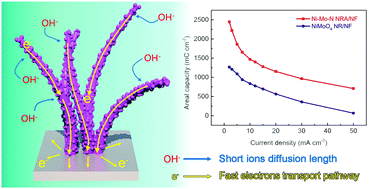Our official English website, www.x-mol.net, welcomes your
feedback! (Note: you will need to create a separate account there.)
Ni nanoparticles@Ni–Mo nitride nanorod arrays: a novel 3D-network hierarchical structure for high areal capacitance hybrid supercapacitors
Nanoscale ( IF 5.8 ) Pub Date : 2017-10-12 00:00:00 , DOI: 10.1039/c7nr05560a Yunjun Ruan 1, 2, 3, 4 , Lin Lv 1, 2, 3, 4 , Zhishan Li 1, 2, 3, 4 , Chundong Wang 1, 2, 3, 4 , Jianjun Jiang 1, 2, 3, 4
Nanoscale ( IF 5.8 ) Pub Date : 2017-10-12 00:00:00 , DOI: 10.1039/c7nr05560a Yunjun Ruan 1, 2, 3, 4 , Lin Lv 1, 2, 3, 4 , Zhishan Li 1, 2, 3, 4 , Chundong Wang 1, 2, 3, 4 , Jianjun Jiang 1, 2, 3, 4
Affiliation

|
Because of the advanced nature of their high power density, fast charge/discharge time, excellent cycling stability, and safety, supercapacitors have attracted intensive attention for large-scale applications. Nevertheless, one of the obstacles for their further development is their low energy density caused by sluggish redox reaction kinetics, low electroactive electrode materials, and/or high internal resistance. Here, we develop a facile and simple nitridation process to successfully synthesize hierarchical Ni nanoparticle decorated Ni0.2Mo0.8N nanorod arrays on a nickel foam (Ni–Mo–N NRA/NF) from its NiMoO4 precursor, which delivers a high areal capacity of 2446 mC cm−2 at a current density of 2 mA cm−2 and shows outstanding cycling stability. The superior performance of the Ni–Mo–N NRA/NF can be ascribed to the metallic conductive nature of the Ni–Mo nitride, the fast surface redox reactions for the electrolyte ions and electrode materials, and the low contacted resistance between the active materials and the current collectors. Furthermore, a hybrid supercapacitor (HSC) is assembled using the Ni–Mo–N NRA/NF as the positive electrode and reduced graphene oxide (RGO) as the negative electrode. The optimized HSC exhibits excellent electrochemical performance with a high energy density of 40.9 W h kg−1 at a power density of 773 W kg−1 and a retention of 80.1% specific capacitance after 6000 cycles. These results indicate that the Ni–Mo–N NRA/NF have a promising potential for use in high-performance supercapacitors.
中文翻译:

Ni纳米粒子@ Ni-Mo氮化物纳米棒阵列:用于高面积电容混合超级电容器的新型3D网络分层结构
由于其高功率密度,快速的充电/放电时间,出色的循环稳定性和安全性的先进性,超级电容器在大规模应用中引起了广泛的关注。然而,它们进一步发展的障碍之一是由于缓慢的氧化还原反应动力学,低电活性电极材料和/或高内电阻引起的低能量密度。在这里,我们开发了一种简单而简单的氮化工艺,以其NiMoO 4前体成功地在泡沫镍(Ni–Mo–N NRA / NF)上成功合成了分层的Ni纳米颗粒修饰的Ni 0.2 Mo 0.8 N纳米棒阵列。的2446三菱商事厘米-2在2毫安cm 2的电流密度-2并显示出出色的循环稳定性。Ni-Mo-N NRA / NF的优越性能可归因于Ni-Mo氮化物的金属导电特性,电解质离子和电极材料的快速表面氧化还原反应以及活性材料之间的低接触电阻和目前的收藏家。此外,使用Ni-Mo-N NRA / NF作为正电极和还原型氧化石墨烯(RGO)作为负电极来组装混合超级电容器(HSC)。优化的HSC表现出出色的电化学性能,在773 W kg -1的功率密度下具有40.9 W h kg -1的高能量密度6000次循环后保留80.1%的比电容。这些结果表明,Ni-Mo-N NRA / NF在高性能超级电容器中具有广阔的应用前景。
更新日期:2017-11-23
中文翻译:

Ni纳米粒子@ Ni-Mo氮化物纳米棒阵列:用于高面积电容混合超级电容器的新型3D网络分层结构
由于其高功率密度,快速的充电/放电时间,出色的循环稳定性和安全性的先进性,超级电容器在大规模应用中引起了广泛的关注。然而,它们进一步发展的障碍之一是由于缓慢的氧化还原反应动力学,低电活性电极材料和/或高内电阻引起的低能量密度。在这里,我们开发了一种简单而简单的氮化工艺,以其NiMoO 4前体成功地在泡沫镍(Ni–Mo–N NRA / NF)上成功合成了分层的Ni纳米颗粒修饰的Ni 0.2 Mo 0.8 N纳米棒阵列。的2446三菱商事厘米-2在2毫安cm 2的电流密度-2并显示出出色的循环稳定性。Ni-Mo-N NRA / NF的优越性能可归因于Ni-Mo氮化物的金属导电特性,电解质离子和电极材料的快速表面氧化还原反应以及活性材料之间的低接触电阻和目前的收藏家。此外,使用Ni-Mo-N NRA / NF作为正电极和还原型氧化石墨烯(RGO)作为负电极来组装混合超级电容器(HSC)。优化的HSC表现出出色的电化学性能,在773 W kg -1的功率密度下具有40.9 W h kg -1的高能量密度6000次循环后保留80.1%的比电容。这些结果表明,Ni-Mo-N NRA / NF在高性能超级电容器中具有广阔的应用前景。











































 京公网安备 11010802027423号
京公网安备 11010802027423号